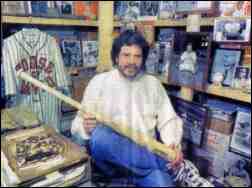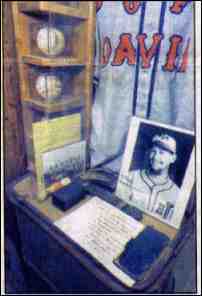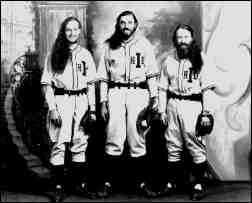












|
The HOUSE OF DAVID BASEBALL TEAM RESEARCH PROJECT
From the
ELKHART TRUTH
January 1, 2001
| Purchase Options |
 Purchase the "House of David Baseball Team" here
Purchase the "House of David Baseball Team" here
|
|
Into the House - House of David baseball becomes Bertolino passion
By STEVE KRAH Staff Writer
UNION - By his own description, Terry Bertolino is a long-time "junker."
Four years ago, his interest in antiques and collectibles took him to a tag sale at the City of David, a religious community in Benton Harbor, Mich.
What began as a hope of securing a piece or two of House of David baseball memorabilia has become an obsession that has spawned a book and a website and will likely lead to more publications. A verbal history and definitive history are in the works.
The Long Lake home the 1967 Goshen High School graduate shares with wife and artist Effrosine is filled with her painting and his assorted treasures.

Avid collector: Terry Bertolino sits in the basement of his Union home with some of the House of David baseball memorabila. Bertolino recently co-authored a pictorial book about the Benton Harbor-based phenomenon.
|
|
The Israelite House of David was founded in 1903 as a religious colony in Benton Harbor and is still in evidence there today.
The colony is credited with inventing the automatic pinsetter used in bowling and the first cold storage facility in the country. However, it's House of David baseball players, with their long hair and beards, which were forbidden to be cut or shaved as a code of their faith, that has given the community its identity throught the world.
The colony split in 1930, but both sides continued to field teams. In the 1930s--the Gold Era of House of David baseball--the House of David employed future Baseball Hal of Famer Grover Cleveland Alexander plus great female athletes Babe Didrikson and Jackie Mitchell. The City of David barnstormed with Satchel Paige's All-Stars. Much like the Negro Leagues of the same period, the House of David baseball players would criss-cross the country, playing with such greats as Paige, the Kansas City Monarchs and Pittsburgh Crawfords.
"I just had bits and pieces of information about the House of David," says Bertolino. "It was just enough to sort of pique my curiosity."
"I had heard of the baseball team. I wasn't sure what I was going to find when I got there (at the tag sale). I was fortunate enough to come away with a coupe of broadsides and a trunk that was (former player) George Anderson's when he played on the baseball team."

Anderson's trunk: The article that launched a House of David Baseball obsession is this trunk belonging to former player George Anderson that Terry Bertolino purchased at a City of David tage sale.
|
|
From that first spark, Bertolino's interest in the House of David baseball grew and grew and he began collecting as much information and photographs as he could. Along the way, he was told about a House of David historian living in Chicago named Joel Hawkins. The two men soon joined forces.
Four years after that tag sale, Bertolino and Hawkins became co-authors of a pictorial book, "Images of America: The House of David Baseball Team" (Arcadia Publishing). The 128-page book has around 200 images spanning the era's four decades (1915-55).
Terry Cannon, curator of the Baseball Reliquary in California, told Bertolino about Hawkins. But Bertolino did not contact him right away.
"I guess I was a little stubborn," says Bertolino. "Like anything, you want to find things out for yourself. You don't want to go to somebody else who's done the research. At least that's the way I am when I start a new project. So I put it aside for about six months."
When the two met, it was learned that Hawkins had started interviewing former players back in 1990 and had done extensive library research. The have gone to the City of David trustee ron Taylor who opened up the archives to them. In the years that followed, scorebooks were uncovered and Bertolino and Hawkins began compiling statistics and rosters.
Lloyd Dalager, president of the House of David, helped identify many of the older photos.
While gathering information for the first book, which was released in 2000, and Internet presence was established: www.peppergame.com. The site is still vital in the exchange of information and selling the book.
Why pepper game?
Pepper, originated around 1922, involved a series of behind-the-back, fake tosses and rolls that came to be billed as worth the price of admission.

Pepper Trio: George Anderson (left), John Tucker and original team member Jesse Lee "Doc" Tally made up the most famous "pepper game" trio fielded by the House of David baseball teams. The pepper exhibition was often billed as worth the price of admission.
|
|
"As far as we can tell, the House of David invented pepper," says Bertolino. "No one else has taken credit."
"It started as a way to loosen up and kill some time while waiting for the other team to arrive," says Bertolino. "And it evolved into the art form."
The most famous pepper team consisted of Anderson, John Tucker, and Jesse Lee "Doc" Tally.
Bertolino considers House of David baseball a national treasure whose story deserves to be told.
"One of the fascinating things about the House of David is you want to find out more about them," says Bertolino, a Society of American Baseball Research member. "How good were they? You realize that they've been passed over and that they deserve more recognition than they've gotten to this point."
"Locally, people know them. Older people who remembered seeing them play. But there is a whole generation or two that really know nothing about them."
Bertolino hopes the Hosue of David will be recognized at the National Baseball Hall of Fame and Museum in Cooperstown, N.Y., alongside the Negro Leagues.
He and Hawkins are now delving into verbal history.
"There's more of a sense of immediacy with the oral history," says Bertolino. "At least getting the contacts and the phone calls and the interviews done with these people."
"The youngest ones we have played in the 50's and most of them are in their mid-70's."
The pictorial history has been well-received by the men in the photos.
"We've gotten good reviews from former players," says Bertolino. "It's brought back memories."
In addition to the teams out of Benton Harbor, many others identified themselves as the House of David, most notably those sponsored by former House of David promoter Louis Murphy.
"It's a very confusing issue because there are so many House of David teams out there," says Bertolino. "Our research ahs branched out. We want more information now on the teams that played under the House of David moniker so we can put this into a proper historical perspective."
"It didn't take too long to grow a beard and with all of the imposter tems, that's all you saw--a bearch. There was no long hair. That was an easy way early on identify the real team from imposter teams."
Ironically, Bertolino wears a beard which helps keep his face warm as a meter reader for American Electric Pwer. He has had the whiskers most of the time since his days at the University of California at Santa Cruz.
"This is much of a beard," says Bertolino, 51. "I don't think I could qualify for a legitimate House of David player."
But he's doing what he can to secure the real players' place in baseball history.
|





